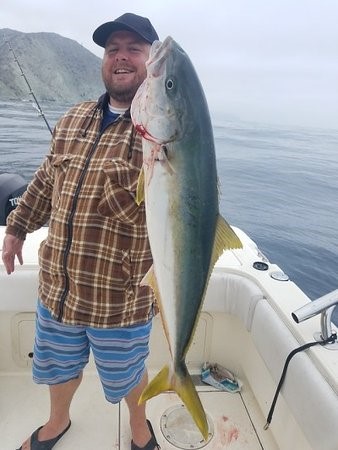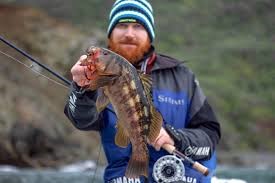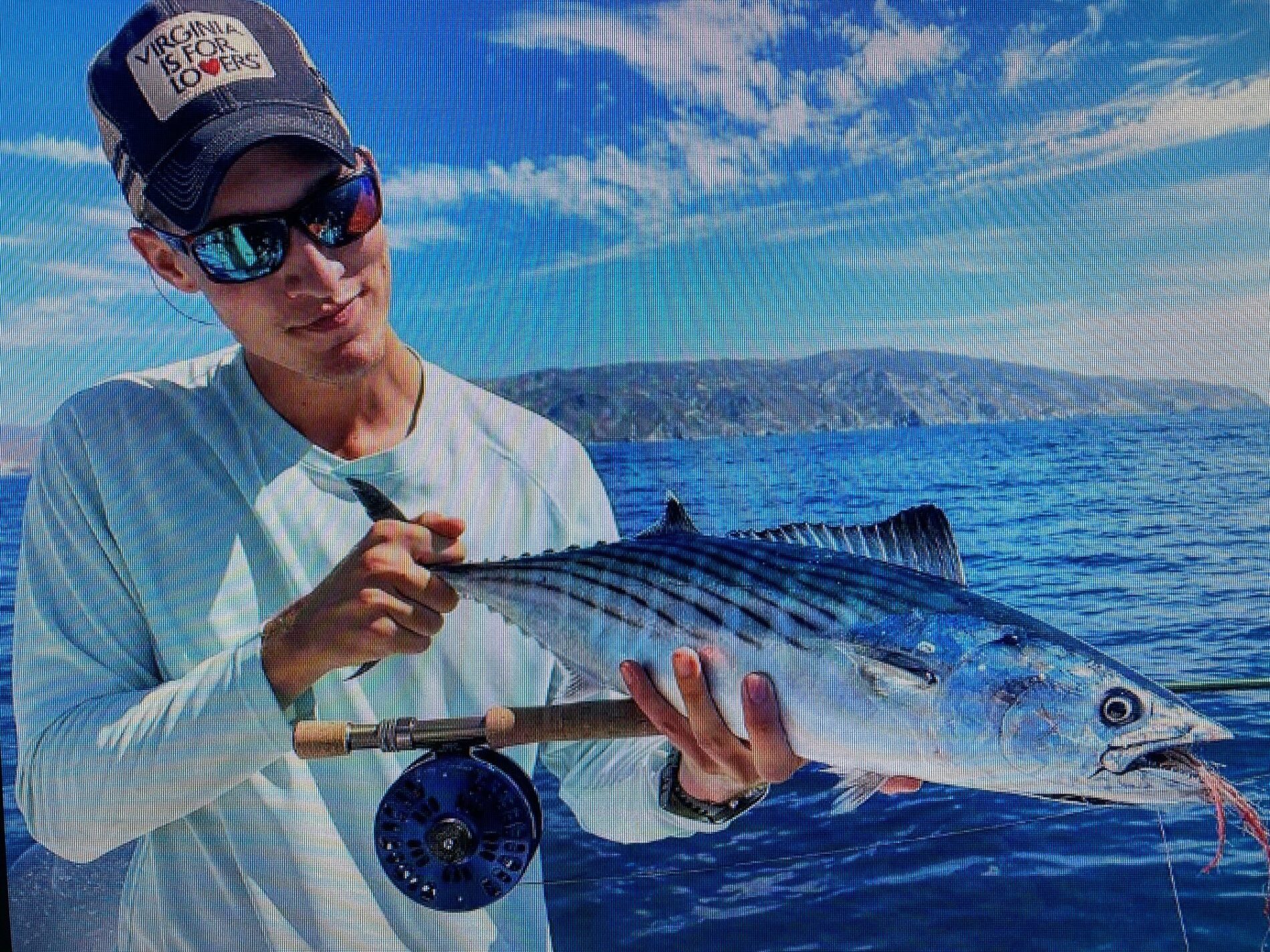Catalina Fly
Catalina Fly-coastal
Many new combers to fishing and the “Old Guys” set in their ways, have only one picture in their head of ocean fishing. That of a boat with 40 guys standing side by side on a “Cattle” boat fishing with heavy rods and big bulky reels, stuck for a day and a half with no where to go. Likewise they picture of a ‘Fly-fisherman’ with his waders on standing half way in water, in a stream up in the Sierra’ somewhere. Contrary to that the Fly-fisherman we are talking about are on the back 18’ to 25’

Fishing boat forty yards off the rocky shore off Catalina Island in southern California on the Pacific Ocean. These dudes are mostly wearing board shorts, (TunaGodz.com) t-shirts, and sandals.
The fly line shoots across the water like a fighter jet flying swooping down—quickly with precise accuracy direct aim for the target. While the yellowtail moved with power and speed it created a mark of linear perfection, and easily burned 90 feet away from the boat without any signs of fatigue. Just a few yards away loomed a kelp forest—safe haven for the California yellowtail but a tangle of trouble for me. Keeping a smooth load on the fly rod, I arched the tip low and to my left to make the butt of my rod work against the fish, and pressure it toward open water. This yellowtail turned back in the direction of the boat and went under. The yellowtail being very intelligent tries to find any way to get out of the hook. They will go away from the surface and dive down like this one did, bending and pulling the rod tip into the water with on forceful move. The rigorous fight moved strongly back and forth to either side of the boat, till finally making a terminal swim close to the boat where it was netted and landed on deck.
These are lessons every trout fisherman has to learn on a jaunt to Catalina Island, and that’s just landing the fish. First you have to find them. Fishing the east side of the island hopefully will put you on the yellowtail. These are well known classic coves, deep shelves, rocky cover, flats, and large kelp forests.
About Pacific Fly Fishing
[Saltwater fly fishing experiences for 2 people off the Southern California coastline and offshore based out of Huntington Beach. Spend a day fly fishing beautiful and rugged Catalina Island for big Yellowtail on 12 weights or head offshore and drift waiting for a massive Mako shark to show up and put that 16 weight to the test! Half to full day rates are available for chasing saltwater species such as: mako sharks, yellowtail, calico bass, yellowfin tuna, and Dorado. Please check website for seasonal availability and pricing.]
Catalina’s shoreline environments present a world-class testing ground for all your skills. It’s a year-round fishery with four important gamefish: California yellowtail, Pacific bonito, barracuda, and calico bass. Though each species has a premier window of opportunity, there’s plenty of overlap, including the chance at a “grand slam” in the summer months.
Of the four species, California yellowtail are perhaps the most glamorous due to their large potential size and powerful fighting style.

California Yellowtail (Seriola lalandi dorsalis) without question this is one of the angler’s favorite gamefish. In all the oceans of the world SoCal can match hand to hand with any other waters across the globe. These California yellowtail are robust, consistently accessible, and comprised of high-quality specimens. They’re sleek packages of electrifying muscle. In general the population is loaded with firecracker models from 2 to 7 pounds but there are more than enough 8- to 15-pound beauties around to keep it interesting. Yellowtail grow well beyond 70 pounds, so the potential maximum size becomes quite a feet to land on these lighter fly rods.
Yellowtail are kin to amberjacks and almaco jacks and they exhibit the characteristic forked caudal fin, which looks like a large sickle. In contrast, their pectoral fins are quite short. The dorsal and anal fins are long and low in profile for dynamic streamlined efficiency.
The yellowtail migration usually begins to show itself in March and continues a slow build throughout spring, peaking in the summer when major schools inhabit the region through September.
They are a coastal inshore species and spend much of their time in relatively shallow water. Their migratory movement concentrates them around offshore island habitat. Catalina is a major waypoint in their migratory route that moves up Baja through SoCal. It’s a perfect combination of macro and crabs, and micro habitat not just for yellowtail but also for prey species like sardines, anchovies, mackerel, squid, and red crab.
Bonito are quick-hitting little tunas with huge appetites. They grow quickly through the summer, and peak in size in the fall before moving south.
Pacific Bonito (Sarda chiliensis)
They belong to the tuna and mackerel tribe, locally known as boneheads or bonita. Though Pacific bonito inhabits an enormous range from South America to the Pacific Northwest, the greatest concentration is in the stretch from Baja to Southern California.
In the spring, as migratory fish combine with resident species, the Catalina Island population swells. The population peaks in the summer, but if you want to target the larger species, you’re going to want to focus your efforts in the fall after the fish have a full summer growing under their belts, and the smaller fish population has thinned.
The blistering strength of mostly 2- to 6-pound bonito, which is the ideal introduction to the tuna world, will impress you throughout the summer. They have a similar body shape and similar fins. A series of prominent dark oblique stripes give way to a white belly accentuates the blue / green metallic color scheme.
Bonito often visit the same surroundings as yellowtail and feed on the same forage so that each cast can confuse you. Bonito hit hard and fast and put up a running headshaking fight though usually substantially smaller than the yellowtail.
California Barracuda (Sphyraena argentea)
Imagine a 3-foot-long pipe-like shark. It’s long, big, hitting hard. Local anglers can hear barracuda being referred to as stove pipes, but let’s add some vital elements. You need to look at a long tapering snout with a collection of large needle-like teeth at the front end. A compact caudal fin on the opposite end. Although it doesn’t hit the big barracuda’s overall height, our California version still brings an impressive punch.
California barracuda normally patrol the outer edges of kelp forests and cruise over shallow flats and structure of the reef. Mostly they feed on smaller fish that escape from the shelter.
The SoCal barracuda population flies, as a migratory party, between Southern Baja and Point Conception. The northward movement occurs during June, July, and August, and then reverses in fall. In June and July Catalina is perfectly positioned to experience peak action. The ‘cudas’ are usually 3- to 6-pound fish. Anything over three feet is a double-digit trophy fish which enters the domain.
Kelp or Calico Bass (Paralabrax clathratus)
Calico bass are in the same family as groupers and sea bass, and they hunt and eat in similar ways deep within kelp beds and other structures. Kelp Bass is list them as kelp bass, but most anglers use the term calico bass or just “calicos.” It is an excellent descriptor to the camouflage pattern on the back and sides of this gamefish which is a cousin of sea bass and groupers.

All the fish within this family are shaped like bulldozers. The chest is thick with a short caudal stalk, powering a large broom-like tail. Such basses will turn a dime on and they enjoy living in, and power through heavy cover.
Unlike barracuda, yellowtail, and bonito, calicos are closely tied to the reef ecosystem as homebodies. The protection of pinnacles, crevices, caves, and kelp forests is crucial. It is important to see more and larger calicos to get your flies deep into these spots, but it is also a zone that causes abrasion and entanglement in the line and the fly. This is the realm of a wartime mega-tug. To cover up you are fighting close. You exploit the structure, and you pry away. You can’t be scared of the world because it can kill you sometimes.
Calicos’ mouth arrangement helps them to catch much of any edible object they want. For these basses, crustaceans large and tiny, a wide range of fish, including baby octopi and squid, are fair game. This is a forage base designed for sustainability during the year.
Catalina calicos ranges between 1 and 10 pounds or more. Pre-spawn activity rolls from March to May, and during the summer months spawning takes place. Both autumn and winter provide fly fishermen access to some of the year’s largest specimens.
Best Choice of Gear
Both 8- and 10-weight rods have places for the variety of species around Catalina. The lighter rod is a match for bonito, calicos, barracuda, and firecracker yellowtail. The heavier outfit lets you handle larger fish and given the variety of sizes you’ll find there, I believe a 10-weight is the best all-around outfit.
Your line selection doesn’t have to be complicated. In the summer, use any tropical sinking-tip saltwater line or full intermediate line. Floating lines can produce occasionally, but sinking-tip and intermediate lines are better to defeat the coastal hydraulics, and get your flies down to the fish.
Straight leaders of 20-pound-test fluorocarbon monofilament 6 to 7 feet long are common. Tie a Bimini knot at the butt end to connect to your fly line. At the front of the leader, use a no-slip loop knot to connect to the fly. It’s not IGFA legal, but it’s simple and helps you land fish quickly. If you get into a bunch of small bonito, then 12- to 14-pound-test monofilament is fine.

For barracuda, use a RIO Products tippet ring at the end of the leader and then add another foot of 30-pound-test fluorocarbon as a bite tippet. It is believed that California barracuda can be “wire shy” and prefers to merely replace the 30-pound tippet after each fish.
Like all fly fishermen your shoulder sack is loaded with way to many flies, but this type of fishing is not for delicate ‘sissy’ flies. Leave your weak flies at home.
You really only need three types of flies for Catalina Island: a Closer style fly, a Deceiver-style fly, and a heavy streamer with pronounced jigging action. All these baitfish imitations are approximately 2 to 5 inches long on #1/0 and #2/0 hooks.
Another piece of essential gear is a large landing net. Using one maximizes your ability to control and manage each catch with minimal impact. If you’re a do-it-yourself fly fisher, bring your own net. It’s a game-changer.
Catalina is close to Long Beach, Sunset Beach, and Newport Beach, and if you’ve got your own boat these are logical launch sites. The island is approximately 20 miles off the coast.
You can use TunaGodz.com to help you find the right fly fishing guide for you! Hook’um up!!






